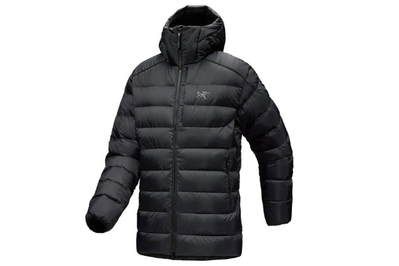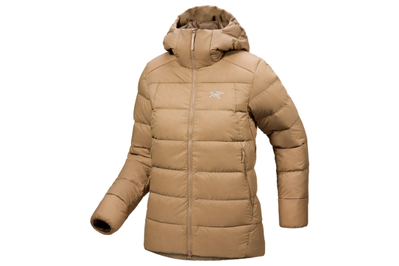Staff pick
Perhaps the biggest aversion people have towards down jackets is the potential for looking like the Michelin Man. Nobody wants to feel immobilized by puffiness or traipse around town looking like a marshmallow. However, down jackets on the thinner end of the spectrum are usually too thin to keep you warm in the dark days of January and February.
As a result, my search for the right coat began something like a riddle: I asked the salesperson to help me find the least puffy jacket that I could still wear as a single layer on the coldest days of a New York winter. The Thorium Hoody was the only one that fit the bill.
Arc’teryx is known primarily for its high-end, largely synthetic hiking gear. In 2013, the Thorium Hoody was a relatively new item in its lineup, and as one of the lone garments made primarily of down, it represented a unique product category for the brand.
Unlike down layering pieces, the Thorium Hoody is designed as a standalone layer without looking overly puffy. Despite its slightly beefier build, it can still be smushed down into a parcel roughly the size of a Chipotle burrito when packed into its stuff sack.

The original Thorium jacket falls right at the hip, with a slightly fitted waist and a gently curved hem. These subtle style elements add to the jacket’s charm and keep you from looking like a schlub, but in my experience they also allow for a little more freedom of movement, while many other standalone down jackets can feel constricting. The jacket’s throat is also high enough to act as a scarf when zipped all the way, which adds another dimension of warmth.
The Thorium Hoody further separates itself from most other down jackets with its inclusion of synthetic insulation in places that tend to see the most rain in a downpour: the cuffs, shoulders, and hood. Though down is generally a tremendous insulator, it tends to lose some of its heat retention when wet, whereas synthetic insulation still performs well if soaked through. This adaptability offers the best of both and is particularly useful for city life, where I often find myself caught in a flash of winter rain without an umbrella.

Although the Thorium Hoody is a standalone layer, you won’t overheat in it, and it’s easy enough to throw on over just about anything, whether that be over a sweater in January or a T-shirt in April.
Three small flaws have appeared over time. The first is that its pockets are largely unsupported, so storing anything substantial means the jacket begins to look droopy.
The second is that the shell material can start to look crinkly over the course of a season. Arc’teryx has since replaced the shell material on newer models, but with a lower-denier fabric. This might help it shed creases more easily but also probably makes it more susceptible to snags.
The third is petty and has to do with the hood. It is, indeed, a very warm hood, but it was not designed for style. It is slightly bulbous and likely shaped to accommodate a climbing helmet, which means that I look silly with it on. That said, the hood allows for good visibility, whereas other insulated hoods often require owl-like head-turning in order to look to the side.
In the last 12 years, Arc’cteryx has made a few notable improvements to the original Thorium Hoody. Its pockets are now lined with fleece rather than the external fabric, which sounds a lot cozier. Newer versions also have a two-way zipper, a breast pocket, and slightly less obvious divisions between areas of down and synthetic. While the original feels very thoughtfully designed, these are all small touches that I would really love to have had on my first-gen Thorium jacket.
More than anything else, it is the Thorium’s build quality and durability that has shone through over the last 12 winters of relentless wear. While I tend to be more careful with my clothes than most, especially with investment pieces, nobody is that careful. The jacket has been dealt a few blows: There’s the gaping hole that I put into the sleeve on a trip to Paris several years ago, which has been covered with an unsightly patch ever since. In the winter of 2020, the stitching on the back started to come undone. Two winters ago, the zipper pull snapped in half.
I have never really rotated my jacket, and consecutive days of wear without rest puts exponentially more mileage on a garment. And being irregular about cleaning it (read: twice in 11 years) means that the down has also clumped together and lost a lot of its loft.
Attached to the jacket as I was, it had started to look a little stale, and it was no longer really keeping me warm. This year, I finally took my jacket into Arc’teryx after the launch of its in-store repair program, ReBird.
Arc’teryx used to have one of the more inscrutable warranty repair processes: no in-store service, long wait times of six to eight weeks, a cleaning fee if the garment did not arrive laundered, and repairs that were only sometimes free—all of which was enough to discourage me from sending my jacket in for repair for several years. This, however, is no longer the case.
I visited ReBird in New York and was shown a menu of what it offers customers, from simple zipper pull replacements to full panel repairs on Gore-Tex jackets—all at no cost. ReBird, whose goal is to keep items out of landfills, will also wash and dry jackets (which, if you, like me, are anxious about washing one of the most expensive items in your closet, is a major benefit).

At roughly $600, the Thorium Hoody now costs far more than it did a decade ago (I bought it for roughly $300 on sale), and the thought of spending that much is certainly hard to stomach. However, with how well the jacket has treated me over the years, and having witnessed its unfaltering durability, I would have spent that sum to replace it, especially given Arc’teryx’s extensive repair program and the many design improvements.
ReBird returned my renewed jacket to me in less than a week. It greeted me at the counter like an old friend, restored to a long-forgotten glory. Holding the jacket in my hands, it felt suddenly so airy and light, no longer bogged down by dirt and oil that had accumulated in its feathers over many years.
Arc’teryx had not only replaced the zipper pull, but the entire zipper itself, which now glides so seamlessly that I marvel at it every time I put it on. The failing stitching on the back has been resewn, and the emergency patch I’d stuck to the sleeve years earlier has been replaced with matching fabric. After being cleaned, the jacket’s shell is back to its former, slightly matte shade of black, and most importantly, the insulation has far more loft than it did when I handed it over. The jacket was, once again, ready to shed wind and cold during the single-digit weeks of mid-January. Its 12th winter would no longer be its last.
When the jacket came to me in my early 20s, I never expected it to last as long as it did, nor did I realize that it signaled a moment in time when I had finally started to grasp some greater notion of properly looking after myself, which perhaps was what my grandmother was trying to communicate all along. Year after year it has remained impenetrable, traveling with me across the world and back home again, still carrying on. Few items last from your early 20s to your mid-30s, and yet, this jacket did.
Which is to say, I no longer think a good winter coat is for chumps.
This article was edited by Hannah Rimm and Maxine Builder.






